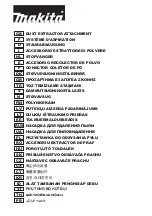
Model No. WA-9857
String Vibrator
17
®
L =
L =
l
l
3
2
L =
l
1
2
Experiment 2:
Standing Waves In Strings
Purpose
The general appearance of waves can be shown by means of standing waves in a string. This type
of wave is very important because most of the vibrations of extended bodies, such as the prongs of
a tuning fork or the strings of a piano, are standing waves. The purpose of this experiment is to
study how the speed of the wave in a vibrating string is affected by the stretching force and the
frequency of the wave.
Theory
Standing waves (stationary waves) are produced by the
interference of two traveling waves, both of which have the
same wavelength, speed and amplitude, but travel in
opposite directions through the same medium. The necessary conditions for the production of
standing waves can be met in the case of a stretched string by having waves set up by some vibrating
body, reflected at the end of the string and then interfering with the oncoming waves.
A stretched string has many natural modes of vibration (three examples are shown above). If the
string is fixed at both ends then there must be a node at each end. It may vibrate as a single
segment, in which case the length (L) of the string is equal to 1/2 the wavelength (
λ
) of the wave.
It may also vibrate in two segments with a node at each end and one node in the middle; then the
wavelength is equal to the length of the string. It may also vibrate with a larger integer number of
segments. In every case, the length of the string equals some integer number of half wavelengths.
If you drive a stretched string at an arbitrary frequency, you will probably not see any particular
mode; many modes will be mixed together. But, if the tension and the string's length are correctly
Equipment Required
Part Number
String Vibrator
WA-9857
Power Supply
Part of WA-9857
Inelastic Braided String
SE-8050 or similar
Clamp or other device of securing the String Vibrator
SE-7286 or similar
Super Pulley
ME-9450
Mounting Rod for Super Pulley
SA-9242
Universal Table Clamp
ME-9472 or similar
Mass and Hanger Set
ME-8967 or similar
Balance
SE-8765A or similar
Tape Measure
SE-8712A or similar
Summary of Contents for WA-9857
Page 26: ......










































